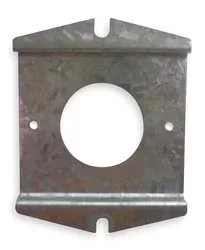( Knowledge by
Scott Williamson )
The NPS40 is one of those stoves where a simple oversight in the maintenance can lead to very devastating results. It all has to do with the ignition off switch. This switch is located under the auger motor on the back of the exhaust port that leads off of the refractory over to the combustion motor. The mounting for this switch is inset into the exhaust; there is a hole cut out in the steel for it to seat into. If the exhaust gets too hot, your igniter switch can melt.
The ignition switch is NOT thermally protected (not ceramic) but is located in an insert mount in the exhaust path. Let's understand why...
The igniter switch is "open on rise", which is backwards from a proof of fire switch, such as the thermally protected switch locate inset on the exhaust of the combustion blower on the same unit. Why is that switch ceramic? Cause the exhaust is hot ya'll! Duh? And. That switch is made for an inline draft blower to detect proof of fire on rise.Why is the ignition switch plastic...? Cause it is made to be a fan controller or other such for HVAC purposes. A switch re-purposed, which oddly enough, most pellet stove parts are...re-purposed controls and motors. When you dive into it...you'll find that many parts are the same, just used differently.
The igntion switch is normally closed. When the unit is started there needs to be current flowing to the ignitor, however as long as there is heat, the current needs to be shut off. This is done by the L120-10 ignition switch. AT 120°F in exhaust temp the power to the ignitor is cut off via this switch and will remain off until the unit has cooled to 10°F below 120°F ...so at 110°F degrees the ignition switch snaps back closed to ready for the next use.
The proof of fire on this unit is a F140-20 switch, so at 140°F in exhaust temp the unit then send power to the timer boxes to maintain operation. When the fire goes out and cools to 20°F below 140°F power to the unit is turned off. The ignition switch will still be open at this time because it is waiting for the temp to get to 110°F, but at that time there is no power so the unit sits dormant waiting for the rocker switch to be pressed again.
So here is the problem....
Many folks neglect to keep the convection motor clean or maintain enough air flow to efficient remove excess heat from the exhaust. If the unit is running effiecint, the temp is the exhaust should not exceed 300°F and therefor the ignition switch will be spared.
If the ignition switch fails the igniter will stay on the whole time the unit is running and this will burn out the igniter. Check the ignitor resistance when installing a new ignition switch. The proper resistance through
the ignitor should be 30 to 50 ohms +/- 3 ohms.
If the ignitor fails and shorts it may also short out the on-off timer box. this is the blue box under the convection blower with the two leads going to it. The auger timer box is the other blue box with more leads attached.
To test whether the on-off timer box is bad simply plug the unit in. If the combustion blower turns on without turning the unit on or fails to turn on when the heat knob is turned on, you may have a bad timing box or other problems.
This whole cataclysmic event can be averted by simply making sure that the ignition switch does not fail.
Here is my fix. To preserve factory equipment you need to keep the convection motor clean. To prevent this in the future you need to make the switch a surface mount.
The ignition switch needs to be removed from the inset and the hole covered to a install the switch to a surface mount. To do this I mount in a switch face from the broken switch (separate the metal plate from the plastic switch) and silicone it in the mounting hole or cover the hole with a piece of stainless plate. Then install a surface mount bracket to hold the switch off of the surface.

Mounting bracket part number in Grainger Catalog, #2E853 $4.86
New Ignition switch part number in Grainger Catalog, #2FBT6 $5.98
A fix for under $11.00
Or wait and pay big time.
New Napoleon Igniter Switch - $29.99
Igniter - $87.99
Igniter gasket - $5.00
On-Off Timer Box - $115.00
Total - $237.97
I saw this problem yesterday and see it about 12 times a year.
(Posted by Scott Williamson in this thread:
http://www.hearth.com/talk/threads/napoleon-nps40-ignition-switch-fix.69378/)


